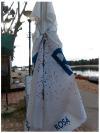The Introduction and Establishment of Four Invasive Insect Species in Serbia
- PMID: 37754696
- PMCID: PMC10531987
- DOI: 10.3390/insects14090728
The Introduction and Establishment of Four Invasive Insect Species in Serbia
Abstract
Urban areas are often populated by specific species of insects, some colorful and appealing, such as ladybugs and butterflies, and others irritating as nuisance bitters or as vectors of pathogens of public health importance. Mosquitoes in urban areas often utilize habitats adjacent to human residences, while phytophagous insect species such as stink bugs often colonize ornamental plants and utilize human-made structures including houses as overwintering shelters. This article discusses the early detection and the current distribution of two invasive mosquito species, Aedes albopictus Skuse 1894 and Ae. japonicus (Theobald 1901), in Serbia, introduced in 2009 and 2018, respectively. From the first findings until today, regular monitoring has been carried out and the establishment of both species in the newly invaded areas has been confirmed. Both species can become nuisance species, especially at high population densities, but more importantly, they are capable of transmitting a wide variety of arboviruses of public health importance. This article also discusses two invasive stink bug species Halyomorpha halys Stål 1855 and Nezara viridula Linnaeus 1758, introduced in Serbia in 2015 and 2008, respectively. These two stink bug species have also been monitored, and the establishment of their populations in the country has been confirmed. Both species have caused damage to a wide range of crops and ornamental plants and sometimes become nuisance pests in urban areas.
Keywords: mapping; mosquito-borne diseases; mosquitoes; nuisance; stink bugs; urban zone.
Conflict of interest statement
The authors declare that the research was conducted in the absence of any commercial or financial relationships that could be construed as a potential conflict of interest.
Figures







References
-
- European Centre for Disease Prevention and Control, ECDC . The Climatic Suitability for Dengue Transmission in Continental Europe. ECDC; Stockholm, Sweden: 2012.
-
- European Centre for Disease Prevention and Control . Guidelines for the Surveillance of Invasive Mosquitoes in Europe. ECDC; Stockholm, Sweden: 2012. [(accessed on 4 June 2023)]. Available online: http://ecdc.europa.eu/en/publications/Publications/TER-Mosquitosurveilla....
Publication types
LinkOut - more resources
Full Text Sources

